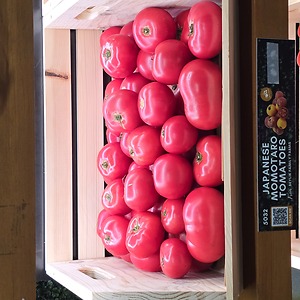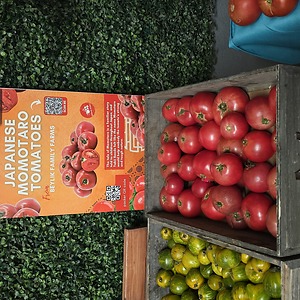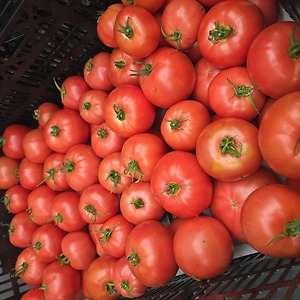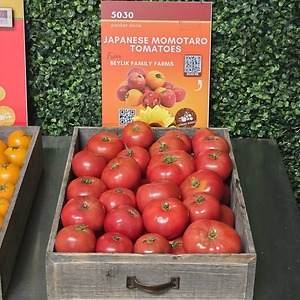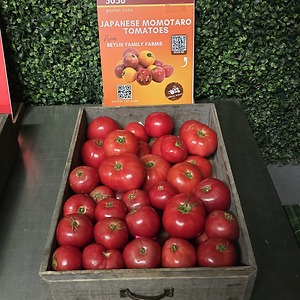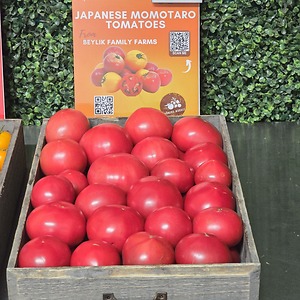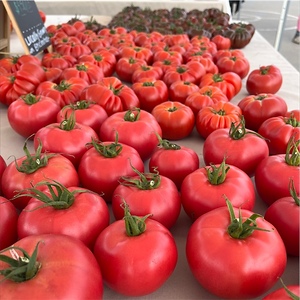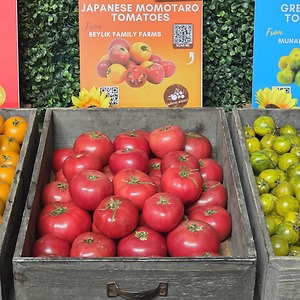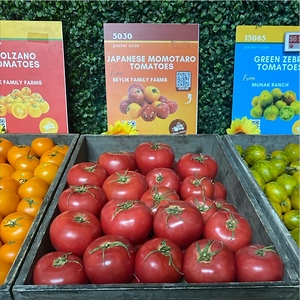

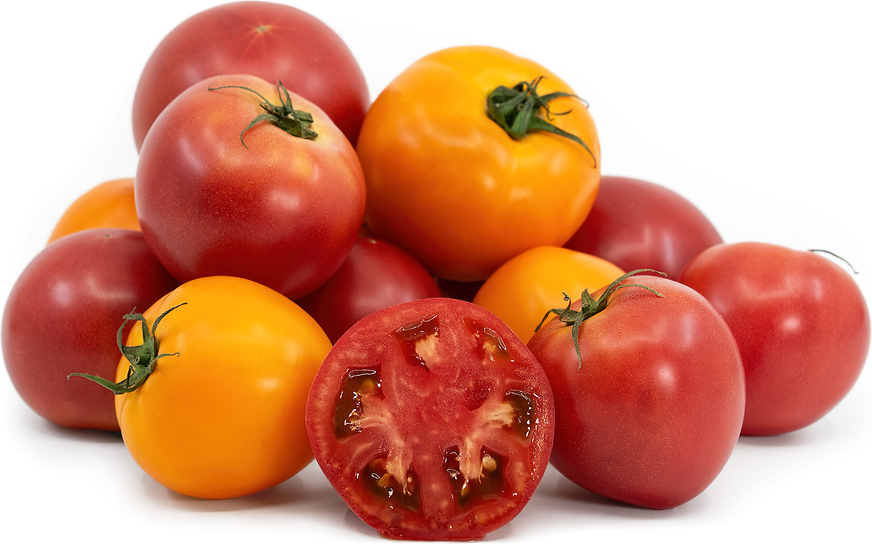
Japanese Momotaro Tomatoes
Estimated Inventory, lb : 37.22
This item was last sold on : 07/31/25
Description/Taste
Momotaro tomatoes are a small to medium-sized varietal, depending on growing conditions, and average 5 to 7 centimeters in diameter and 170 to 250 grams in weight. The round-to-ovate tomatoes have flat shoulders and are capped with a dark green calyx showcasing 6 to 8 narrow, pointed, and elongated leaves. The slender leaves are often curled, forming a star-like shape around the stem. The skin is semi-thick, smooth, and taut, and the area surrounding the stem occasionally exhibits faint creases. Momotaro tomatoes have a pale red, sometimes red-pink appearance, a distinguishing feature from other darker red varieties. There is also a Gold Momotaro variety. Underneath the surface, the red flesh is dense, aqueous, meaty, tender, and succulent. The flesh also encases several chambers filled with tiny yellow-brown seeds suspended in a gel-like liquid. Momotaro tomatoes release a light, vegetal, and earthy scent when ripe. The variety has a high sugar content and low acidity, creating a sweet, full-bodied, umami flavor with bright, tangy nuances.
Seasons/Availability
Momotaro tomatoes are available year-round when grown in greenhouses. Outdoors tomatoes have a peak season in the summer.
Current Facts
Momotaro tomatoes, botanically classified as Solanum lycopersicum, are a Japanese hybrid belonging to the Solanaceae family. The light red-pink tomatoes are an indeterminate type, meaning the vines will climb and extend to varying lengths, providing multiple harvests throughout the season. Momotaro tomatoes are also an extra-early maturing cultivar, ready for harvest approximately 70 to 80 days after sowing and grow in clusters of up to seven tomatoes. The first Momotaro tomatoes were released to commercial markets in Japan in the mid to late 20th century. The sweet, subtly tangy variety quickly became one of the most popular cultivars grown and sold in Japan and has remained a commercial favorite. In the modern-day, the term Momotaro has expanded to include over twenty-five varieties with varying names such as Momotaro Haruka, Hope, Peace, Wonder, House, Grande, Sunny, and Gold. It is also important to note that some new varieties of Momotaro tomatoes are golden yellow in color. Momotaro tomatoes are favored by growers for the tomato’s hardy nature, resistance to disease, heat tolerance, and ability to withstand cracking. In Japan, Momotaro tomatoes are enjoyed in fresh preparations. Outside of Japan, the variety is increasing in notoriety and is being cultivated on a small scale for fresh and cooked preparations in the United States and Europe.
Nutritional Value
Momotaro tomatoes are a source of vitamin C to strengthen the immune system, vitamin K to assist in faster wound healing and support bone strength, and vitamin A to maintain healthy organ functioning. The tomatoes also provide potassium to balance fluid levels within the body, fiber to regulate the digestive tract, and lycopene, a pigmented carotenoid that provides antioxidant properties to protect the cells against the damage caused by free radicals.
Applications
Momotaro tomatoes have a sweet, subtly tangy flavor suited for fresh preparations. In Japan, tomatoes are preferred for raw dishes to appreciate the flesh’s delicate flavor and texture, and most tomatoes are incorporated into Western-style recipes. Momotaro tomatoes can be carved as an edible garnish, chopped and added to salads, or sliced and sprinkled with salt and pepper, served as a refreshing snack. The tomatoes can also be cut and layered into caprese, added to sandwiches, burgers, and paninis, or mixed into herb side dishes. While uncommon in Japan, Momotaro tomatoes sold in the United States and Europe are also favored for cooked preparations. The tomatoes can be incorporated into soups, stews, and chiles, blended into pastes, used as a topping over pizza, or simmered into sauces for pasta and roasted meats. They can also be used in any recipe calling for common red tomatoes. Momotaro tomatoes pair well with fruits such as watermelon, peaches, and strawberries, cucumber, feta, red onion, and herbs, including rosemary, basil, and oregano. Whole, unwashed Momotaro tomatoes will keep for two weeks when stored in the vegetable drawer of the refrigerator.
Ethnic/Cultural Info
Momotaro tomatoes were named after a famous Japanese folkloric hero. The legend of Momotaro recounts how two peasants discovered a giant peach floating in the river. The peach was opened to reveal a child known as Momotaro, and the child claimed the gods had sent him. Momotaro grew up to be a great fighter and defeated many demonic enemies, eventually being named the “Warrior of Peace.” The tale of Momotaro is a familiar story told to children throughout Japan, and Takii Seeds felt like the name Momotaro would help embody the tomato’s strong and tough nature. The company also understood that Momotaro was a familiar and well-known story, allowing consumers to easily connect with the tomato’s branding. In addition to the whimsical story of the peach birth, the character Momotaro was said to have been from Okayama, Japan, and each fall, a Momotaro Tomato Day is celebrated in Okayama to promote local tomato cultivars. In the United States, Momotaro tomatoes are also sold under the name Tough Boy, a descriptor given to loosely reference the tale of the Japanese warrior.
Geography/History
Momotaro tomatoes were developed by the Takii Seed Company in Japan in the mid-20th century. Before their release, tomato varieties in Japan throughout the 19th and early 20th centuries were traditionally more acidic and were harvested young to protect the tomato’s delicate skin from being damaged in shipments. The young tomatoes were deemed flavorless and too acidic, leading many households throughout the country to avoid tomatoes altogether. Public perception began to change in the 1950s when cherry tomatoes were introduced from Europe and the United States. The small cultivars had tougher skin with increased disease resistance, allowing them to be shipped when ripe, developing improved flavors. The Takii Seed Company noticed the need for a hardier tomato variety in the Japanese market and began developing a new cultivar with a firmer nature, disease resistance, and flavor in the late 1960s and early 1970s. Over fifty tomato varieties were naturally crossbred and studied in the selection process, and it took six years before the research team had found a tomato with preferred hardiness. Breeders continued to select and cross various tomato varieties to introduce traits of improved flavor along with color and texture. In 1979, the first version of Momotaro tomatoes was developed. The variety was completed in 1983 and was initially met with criticism among industry professionals, believing the tomato was too firm. Despite the criticism, Momotaro tomatoes were released in 1985 and were favored for their improved flavor, as the tomatoes could be left on the vine for more extended periods and shipped without being damaged. Momotaro tomatoes eventually became one of the most popular types of tomatoes in Japan, forever altering the country’s perspective surrounding tomatoes. Today many new varieties of Momotaro tomatoes have been created to expand the successful line, and tomatoes, in general, have become one of the most popular produce items consumed in Japan. Momotaro tomatoes are primarily cultivated and sold in Japan. The tomatoes have also been introduced into Europe and the United States as a specialty cultivar and are grown on a smaller scale for sale through select distributors and farms. Momotaro tomatoes are also offered through online seed catalogs for home garden use worldwide.
Featured Restaurants
Restaurants currently purchasing this product as an ingredient for their menu.
| The Guild Hotel | San Diego CA | 619-764-5108 |
| Estancia Adobe | San Diego CA | 858-550-1000 |
| Ctzn | Solana Beach CA | 858-925-7141 |
| Kinme (Deliver to Azuki) | San Diego CA | 619-238-4760 |
| Starlite Kitchen | San Diego CA | 619-358-9766 |
| Addison Del Mar | Del Mar CA | 858-350-7600 |
| Espadin | Temecula California | 951-383-5585 |
| Matsu | Oceanside CA | 760-717-5899 |
| Steady State Roasting | Carlsbad CA | 760-908-1680 |
| Hilton La Jolla Torrey Pines | La Jolla CA | 858-450-4581 |
| Copper Kings | San Marcos CA | 323-810-1662 |
| Kinme Omakase | San Diego CA | 619-231-0700 |
| Mabel's Gone Fishing | San Diego CA | 619-228-9851 |
| Miho | San Diego CA | 619-365-5655 |
Recipe Ideas
Recipes that include Japanese Momotaro Tomatoes. One
| Epi Curative |
|
Momotaro Tomato Sesame Sauce |
Podcast



